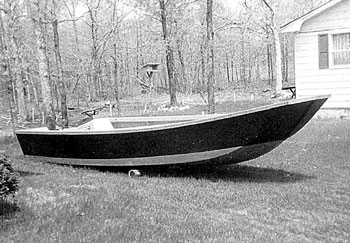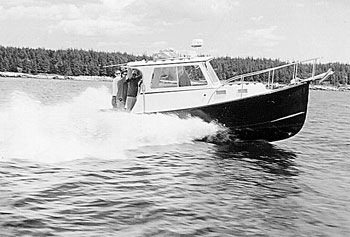T. Jason: Tong Boats to Beals
by Mike Crowe
(This story originally appeared in the January, 2002 Fishermen’s Voice.)

Tong boat, popular with Long Island, NY clammers for its low freeboard and shallow draft. Terry Jason photo.
Up Dyer Bay in Steuben, Maine, T. Jason Boats recently finished a 35-foot fiberglass full planing hull that’s steady at low speed, but can get up and skim over the surface at high speed. Onboard electronics are computerized, including GPS, fuel system, air conditioning, autopilot and more. It’s not a commercial boat, but the design, engineering and construction all have roots in fishing boats. So does Terry Jason. He didn’t start out building fast boats loaded with high tech gear. There were a few twists, turns and bumps on the long road to Steuben.
Both of Terry’s grandfathers were boatbuilders and he worked for one of them in the early ’50s building boats on Long Island, N.Y. His grandfather built lapstrake Jersey skiffs, boats as traditional there as the peapod is in Maine, but he also built tong boats to 40 feet. These low, 24" of freeboard boats were used by clammers. Then there were heavy draggers, head boats to 48 feet, used for fishing over the side and skiffs to 26 feet that were also used for clamming. They were wood boats built in the traditional way; sawn frames, bent frames, carvel planked, laid decks, a thousand different woodworking skills using a hundred different tools.
By 1956 he was building boats on his own, fishing summers and building boats in the winter. There were no lobster boats on Long Island then, but he built everything else. Long Island Sound at the time was thick with an algae the fishermen called “slip gut.” Runoff from agricultural fertilizers had all kinds of stuff growing there, but lobster could not live in it and gillnets were ruined by it.
“The Beals Island type hull...
can get up and go like hell.”
– Terry Jason
In 1964 he began working for a boatyard with four employees. Seafarer Yachts built 22- to 56-foot fiberglass pleasure boats. In the five years he was there the company grew to have 175 employees and Terry was soon production manager building 10 boats a week. It was the early days of fiberglass hulls.
But in 1969 he decided to go back to fishing, clamming and gillnetting. Soon he was building boats himself again. Over the years he said he has built 450 raking (clam raking) boats and 375 garveys (square stem) boats. He has built research boats, Coast Guard certified charter boats, fishing and pleasure boats. Fiberglass as a boatbuilding material had been experimented with in pleasure boats, but by the 1970s it was beginning to be used in fishing boats. Terry built his first fiberglass boat in his own shop in 1972, a 30’ hard chine pleasure boat. The orders came in and the glass boat business was underway.
By 1975 the population density and crowding on Long Island was choking long-time residents. News brought home by his kids that a traffic light was going in at the end of their street led him and his family to decide on moving. They had vacationed in Maine and Terry had hunted here. The family made a couple dozen short trips to look for place to buy. So with a son in college and three other kids in high and elementary schools, they packed up and moved to an old farm in Belfast in 1976. The buildings, built by a local Revolutionary era native, Captain Wadsworth, best known for having turned in Benedict Arnold, included a huge, 75x110-foot barn that was to be the boat shop. Though long neglected, the barn was in great shape. But six months later, almost before the ink dried on property transfer, fire destroyed the barn. The blaze took Terry’s tools, his grandfather’s tools, bandsaws, planers, molds, drawings, patterns and the lumber for three boats.
The uninsured disaster led to a move to Winterport, on the Penobscot above Bucksport. Terry set up shop from scratch, building lobster boats and finishing bare hulls. These included a few Repcos, which were among the earliest Maine-built fiberglass lobster boats. Some boats were built there and sent down to Long Island, N.Y. customers.

Jason built a lot of these pleasure boats and shipped many to the west coast of the U.S., Europe and the Mediterranean. Terry Jason photo.
Three years later and 24 years after starting his own boatbuilding business, with hundreds of boats behind him, he was still 60 miles from his current shop and home in Steuben. In 1980 Terry bought land near the head of Dyer Bay, built the boat shops, his house and outbuildings. He had developed a reputation in Winterport, but in Steuben he was starting again with local customers and a hull design that was new to him.
That new hull design was the Beals Island type. Calvin Beal of Beals Island, built Terry’s first plug and 100 of these 25-foot boats were sold. The mold made on that plug kick-started business in the new location. In fact, Terry thinks the biggest change in boatbuilding in recent years is that the Beals Island type hull has made Maine-built boats popular. At slow speed they are comfortable like a displacement hull, yet their wider, flatter sterns make them full planing hulls that can “get up and go like hell.”
In his first five years at Steuben, half the boats he built were lobster boats. T. Jason Boats now builds about 90% pleasure craft. He has built a lot of certified boats, boats that carry passengers for a fee. The Coast Guard inspects the construction of these boats at various stages of construction. About the process of building in fiberglass, Terry says, “it’s not a lot different than it was in the early days, laying up, etc.” However, “the materials are better today, in particular, the coring sandwiched between the layers of fiberglass fabric.”
Terry still does the lay up by hand, rather than use a chopper gun to apply the fiberglass layers. He says he “has more control doing it by hand, less air in the layers and generally a better job.”
While certified boats have to be built to ABYC (American Boat and Yacht Commission) standards, he has for a long time built all his boats to Lloyd’s of London and ABYC standards. This has made things simpler for him in the long run because his crew knows there are standards for various procedures. Knowing that a particular part is built the same way every time, he says, results in “fewer negative surprises and remakes.” The ABYC sends monthly updates that include new Coast Guard specs of all kinds, such as recent fuel fill changes.
On the boat business he said, “I have never built a boat on speculation. In fact I can’t remember when I didn’t have 5 or 6 boats on order. A well built boat at a reasonable price will bring customers.”
“A well built boat at a
reasonable price will
bring customers.”
– Terry Jason
The business has grown as his reputation has spread by word of mouth, some owners ordering a larger boat or relatives of owners ordering boats. One family has six of his lobster boats, the first built in 1965 and the most recent in 1993. About 20% of Jason Boat customers are in Maine the others are mostly from Connecticut, New York, Long Island, Massachusetts, Boston, and New Hampshire. Since starting in 1956, “60% of the people I have built for have become friends.”
Terry is one of the few fiberglass boatbuilders who began by building wooden boats. Most fiberglass boatbuilders today have never spiled a plank, used wooden boatbuilding tools or designed a wooden boat hull. Most started in by building glass hulls. There is not much nostalgia for wooden boatbuilding at T. Jason Boats, however. In fact last year when he was asked to build in wood he referred the job to a Beals Island shop.
Some people think building in fiberglass is easier than in wood. In the experimental days of the early 1970s it may have been easier. Since then materials and design have come a long way. So while there is no need for a thousand woodworking skills in building a fiberglass boat, there is another set of skills required; one of which is being able to keep up with, understand and use, new materials and technologies that develop continuously. The boats T. Jason builds now are much more complicated than past boats. His son, an electronics engineer, designs and wires the complex systems on some of the boats. As a builder of many wooden boats, Terry has said that building a fiberglass boat right is as difficult as building a wooden boat.
